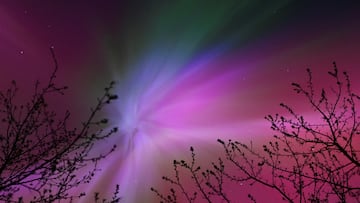LATEST NEWS
The best places to see the Northern Lights Wednesday night: Aurora borealis in the US
The Aurora Borealis, one of nature’s most fascinating displays, is set to shimmer across US skies.

For the second time in a week, the Aurora Borealis is set to streak across the United States - with Wednesday’s showing set to be brighter and more vibrant.
Our Sun’s 11-year solar cycle is approaching its anticipated peak between late 2024 and early 2026, meaning that phenomenons such as solar flares and the Northern Lights are set to become more frequent across the sky.
How can I see the Northern Lights in the United States?
While these things are wildly unpredictable, the optimum time to see the Northern Lights is from any time between 10 p.m. and 2 a.m.
As well as getting your timing right, avoiding city lights and other light pollution, monitoring weather forecasts to ensure you’re below a clear sky and finding a high altitude such as a hilltop are all ways of increasing your chances of having a prime viewing experience as you watch our planet’s magnetic field put up a fight against energised particles from the Sun slamming into the upper atmosphere at speeds of up to 45 million mph (72 million kph).
U.S. states within the aurora’s view line include:
Where can I see the Aurora in the US?
- Washington
- Idaho
- Montana
- North Dakota
- South Dakota
- Minnesota
- Wisconsin
- Michigan
- Maine
- New York (northernmost part)
Why are the Northern Lights different colours?
Billy Teets, the director of Dyer Observatory at Vanderbilt University in Nashville, Tennessee told Space.com that the particles we mentioned before are “deflected towards the poles of Earth by our planet’s magnetic field and interact with our atmosphere, depositing energy and causing the atmosphere to fluoresce. The bright colours of the northern lights are dictated by the chemical composition of Earth’s atmosphere.
“Every type of atom or molecule, whether it’s atomic hydrogen or a molecule like carbon dioxide, absorbs and radiates its own unique set of colours, which is analogous to how every human being has a unique set of fingerprints,” he added.
“Some of the dominant colours seen in aurorae are red, a hue produced by the nitrogen molecules, and green, which is produced by oxygen molecules.” Teet continued.
GOES-U, a satellite launched on one of Elon Musk’s SpaceX Falcon Heavy Rocket, was recently launched and this craft will monitor the high levels of solar activity that have already surpassed the expectations of scientists. The satellite is “the Western Hemisphere’s most sophisticated weather-observing and environmental-monitoring system. The GOES-R Series provides advanced imagery and atmospheric measurements, real-time mapping of lightning activity, and monitoring of space weather”, according to NOAA.






